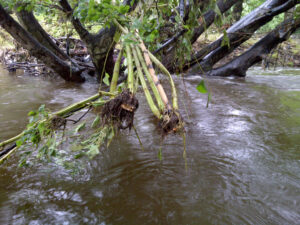
It is well known that invasive species, particularly including Himalayan balsam, can cause erosion on the banks of watercourses. The shallow root system of the Himalayan balsam plant, which dies and decomposes each year after the growing season, combined with the tendency for Himalayan balsam to form dense monoculture stands, results in riverbanks becoming denuded over winter and prone to being washed away by both rain and floodwaters. Loose soils enter the waterway, potentially carrying the seeds of the Himalayan balsam downstream, where they can come to rest, germinate, and spread the infestation to new areas.
This can cause a variety of problems, including affecting water quality, flooding and reducing biodiversity and populations of native plant species, but can also be a particular problem for aquatic animal species including trout, whose young rely on good visibility in order both to catch prey and evade predators. Cloudy water caused by run-off can significantly affect the survival rates of young trout to maturity.
Japanese knotweed was historically planted for the purpose of stabilising railway embankments and also riverbanks, as it was thought that the perennial’s rhizome system would provide a matrix to hold soils together and reduce the chance for soils to be affected by both run-off and landslip. However, the planting of Japanese knotweed has long been suspected of working counter to that goal in riverbanks and, in fact, contributing to riverbank erosion.
Two studies, printed in September 2020 and December 2021 both conclude that, in the areas investigated, the presence of Japanese knotweed was associated with a significant increase in soil erosion – in one study, averaging almost 30mm more soil erosion than areas free from Japanese knotweed.
A number of factors might be at play – one study highlights that Japanese knotweed stem density was a significant factor in increased erosion, while the other suggests that the presence of Japanese knotweed amplifies the erosion forces during a flood event. This may be down to the transfer and concentration of force due to floodwater being transmitted mechanically through canes and crowns; structures which are relatively uncommon in native plant species – particularly at the size found in mature Japanese knotweed infestations.
One other factor which was specifically noted was that Japanese knotweed rhizomes displace the roots of native plants – this is a phenomenon which INNSA contractors frequently observe, with significantly reduced growth of other species tending to be found in Japanese knotweed-infested areas, in comparison with non-JK-infested areas or other areas of typical native habitat. Japanese knotweed rhizomes tend not to be found in the top few centimetres of soils in the areas away from the stems and crowns – although these areas also tend to remain relatively underpopulated by other species – hence the lack of a supporting matrix of roots in the top layer of soil (potentially even down to a depth of around 100mm)
Furthermore, the same problem that is seen with Himalayan balsam – whereby flood-induced erosion can transport seeds to downstream areas, increasing the problem on a watercourse level (and in some cases on a catchment level, where overflooding is observed) can similarly occur with Japanese knotweed, which is noted for its ability to reproduce from fragments as small as one gramme. Flood-induced erosion can carry small sections of rhizome, canes or even entire crowns for long distances downstream – as shown in the picture accompanying this article.
While in so many cases in the UK, it’s too late to prevent watercourses from becoming infested with invasive species, so-called “source-to-sea” programmes have shown a degree of success not just in managing specific invasive species, but in developing the kinds of multi-organisation partnerships (crucially including multiple landowners!) which INNSA believes are key to achieving long term successes in invasive species management Rather than firefighting individual instances of infestations or even simply deploying regular maintenance teams just to prevent a particular site from being overrun due to the presence of invasive species on adjacent riparian land, such partnerships work to the benefit of all concerned by reducing the risks of reinfestation for other landowners, both downstream and in the wider catchment area.
INNSA member companies undertake extensive works near to watercourses – it is thought that ten percent or more of UK permits for the application of herbicide in sensitive riparian areas are granted for the purpose of invasive species management by INNSA members alone. Worryingly, however, this may not reflect the true amounts of works involving pesticides which are carried out in such areas – due to poor practice by unscrupulous or unregistered contractors.
It is critical that such works are carried out with the involvement and approval of the relevant environment agencies, and that these works are carried out by experienced, competent contractors who employ suitably-qualified operatives. The list of specified certificates for such works is relatively limited – at the time of writing, encompassing only certificates issued by two primary providers: City & Guilds and Lantra as well as two Scottish providers: the Scottish Skills Testing Service and the Scottish Association of Young Farmers’ Clubs.
All INNSA members are audited to ensure that (where they carry out works within sensitive areas), they employ such qualified staff and implement the appropriate and necessary measures to ensure both the effectiveness of the works and the safety of the watercourse and riverbanks they work on. It is only with a combination of multi-organisation involvement and active interventions carried out with the greatest care and attention that we can improve the health of our watercourses with respect to invasive plant species.
Left alone, the problem will only continue to get worse.
Chris Oliver
On behalf of INNSA
